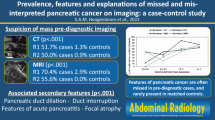Abstract
We examined 20 prediagnostic CTs from 16 patients for whom the diagnosis of pancreatic cancer was delayed until full diagnostic CT was performed. Three radiologists independently reviewed the prediagnostic CTs along with 50 CTs of control subjects, including patients without pancreatic disease (n = 38) or with chronic pancreatitis without calcification visible on CT (n = 12). The reviewers recorded the presence of biliary or pancreatic ductal dilation, interruption of the pancreatic duct, distal parenchymal atrophy, contour abnormality and focal hypoattenuation. Frequency, sensitivity and specificity of the significant findings were calculated. Logistic regression analysis was performed. Findings indicative of pancreatic cancer were seen on 85% (17/20) of the prediagnostic CTs. Patients with pancreatic cancer were significantly (p < 0.05) more likely to show focal hypoattenuation, pancreatic duct dilation, interruption of the pancreatic duct, and distal parenchymal atrophy, with sensitivities and specificities of 75%/84%, 50%/78%, 45%/82% and 45%/96%, respectively. Focal hypoattenuation and distal parenchymal atrophy were the independent predictors of pancreatic cancer with odds ratios of 20.92 and 11.22, respectively. In conclusion, focal hypoattenuation and pancreatic duct dilation with or without interruption, especially when accompanied by distal parenchymal atrophy, were the most useful findings for avoiding delayed diagnosis of pancreatic cancer.




Similar content being viewed by others
References
Schima W, Ba-Ssalamah A, Kolblinger C, Kulinna-Cosentini C, Puespoek A, Gotzinger P (2007) Pancreatic adenocarcinoma. Eur Radiol 17:638–649
Eskelinen MJ, Haglund UH (1999) Prognosis of human pancreatic adenocarcinoma: review of clinical and histopathological variables and possible uses of new molecular methods. Eur J Surg 165:292–306
Smith SL, Rajan PS (2004) Imaging of pancreatic adenocarcinoma with emphasis on multidetector CT. Clin Radiol 59:26–38
Warshaw AL, Fernandez-del Castillo C (1992) Pancreatic carcinoma. N Engl J Med 326:455–465
Li D, Xie K, Wolff R, Abbruzzese JL (2004) Pancreatic cancer. Lancet 363:1049–1057
Tamm EP, Silverman PM, Charnsangavej C, Evans DB (2003) Diagnosis, staging, and surveillance of pancreatic cancer. AJR Am J Roentgenol 180:1311–1323
Prokesch RW, Chow LC, Beaulieu CF, Bammer R, Jeffrey RB Jr (2002) Isoattenuating pancreatic adenocarcinoma at multi-detector row CT: secondary signs. Radiology 224:764–768
Gangi S, Fletcher JG, Nathan MA et al (2004) Time interval between abnormalities seen on CT and the clinical diagnosis of pancreatic cancer: retrospective review of CT scans obtained before diagnosis. AJR Am J Roentgenol 182:897–903
Bronstein YL, Loyer EM, Kaur H et al (2004) Detection of small pancreatic tumors with multiphasic helical CT. AJR Am J Roentgenol 182:619–623
Landis JR, Koch GG (1977) The measurement of observer agreement for categorical data. Biometrics 33:159–174
Demachi H, Matsui O, Kobayashi S et al (1997) Histological influence on contrast-enhanced CT of pancreatic ductal adenocarcinoma. J Comput Assist Tomogr 21:980–985
Kim T, Murakami T, Takamura M et al (2001) Pancreatic mass due to chronic pancreatitis: correlation of CT and MR imaging features with pathologic findings. AJR Am J Roentgenol 177:367–371
Ichikawa T, Sou H, Araki T et al (2001) Duct-penetrating sign at MRCP: usefulness for differentiating inflammatory pancreatic mass from pancreatic carcinomas. Radiology 221:107–116
Lee H, Lee JK, Kang SS et al (2007) Is there any clinical or radiologic feature as a preoperative marker for differentiating mass-forming pancreatitis from early-stage pancreatic adenocarcinoma? Hepatogastroenterology 54:2134–2140
Tanaka S, Nakaizumi A, Ioka T et al (2002) Main pancreatic duct dilatation: a sign of high risk for pancreatic cancer. Jpn J Clin Oncol 32:407–411
Ishikawa O, Ohigashi H, Imaoka S et al (1999) Minute carcinoma of the pancreas measuring 1 cm or less in diameter—collective review of Japanese case reports. Hepatogastroenterology 46:8–15
Hruban RH, Adsay NV, Albores-Saavedra J et al (2001) Pancreatic intraepithelial neoplasia: a new nomenclature and classification system for pancreatic duct lesions. Am J Surg Pathol 25:579–586
Karasawa E, Goldberg HI, Moss AA, Federle MP, London SS (1983) CT pancreatogram in carcinoma of the pancreas and chronic pancreatitis. Radiology 148:489–493
Brune K, Abe T, Canto M et al (2006) Multifocal neoplastic precursor lesions associated with lobular atrophy of the pancreas in patients having a strong family history of pancreatic cancer. Am J Surg Pathol 30:1067–1076
Patlas M, Deitel W, Taylor B, Gallinger S, Wilson SR (2007) Focal chronic pancreatitis mimicking pancreatic head carcinoma: are there suggestive features on ultrasound? Can Assoc Radiol J 58:15–21
Freeny PC, Bilbao MK, Katon RM (1976) “Blind” evaluation of endoscopic retrograde cholangiopancreatography (ERCP) in the diagnosis of pancreatic carcinoma: the “double duct” and other signs. Radiology 119:271–274
Plumley TF, Rohrmann CA, Freeny PC, Silverstein FE, Ball TJ (1982) Double duct sign: reassessed significance in ERCP. AJR Am J Roentgenol 138:31–35
Menges M, Lerch MM, Zeitz M (2000) The double duct sign in patients with malignant and benign pancreatic lesions. Gastrointest Endosc 52:74–77
Ahualli J (2007) The double duct sign. Radiology 244:314–315
Irie H, Honda H, Kaneko K, Kuroiwa T, Yoshimitsu K, Masuda K (1997) Comparison of helical CT and MR imaging in detecting and staging small pancreatic adenocarcinoma. Abdominal imaging 22:429–433
Gore RM, Levine MS (2008) Textbook of gastrointestinal radiology, 3rd edn. Saunders, Philadelphia, PA
Glaser J, Stienecker K (2000) Pancreas and aging: a study using ultrasonography. Gerontology 46:93–96
Acknowledgements
The authors thank Eun Hee Choi, Department of Biostatistics, Severance Hospital, for the statistical consultation and analysis of data.
Author information
Authors and Affiliations
Corresponding author
Additional information
This paper was presented at the 2008 RSNA Annual Meeting.
Rights and permissions
About this article
Cite this article
Ahn, S.S., Kim, MJ., Choi, JY. et al. Indicative findings of pancreatic cancer in prediagnostic CT. Eur Radiol 19, 2448–2455 (2009). https://doi.org/10.1007/s00330-009-1422-6
Received:
Revised:
Accepted:
Published:
Issue Date:
DOI: https://doi.org/10.1007/s00330-009-1422-6




